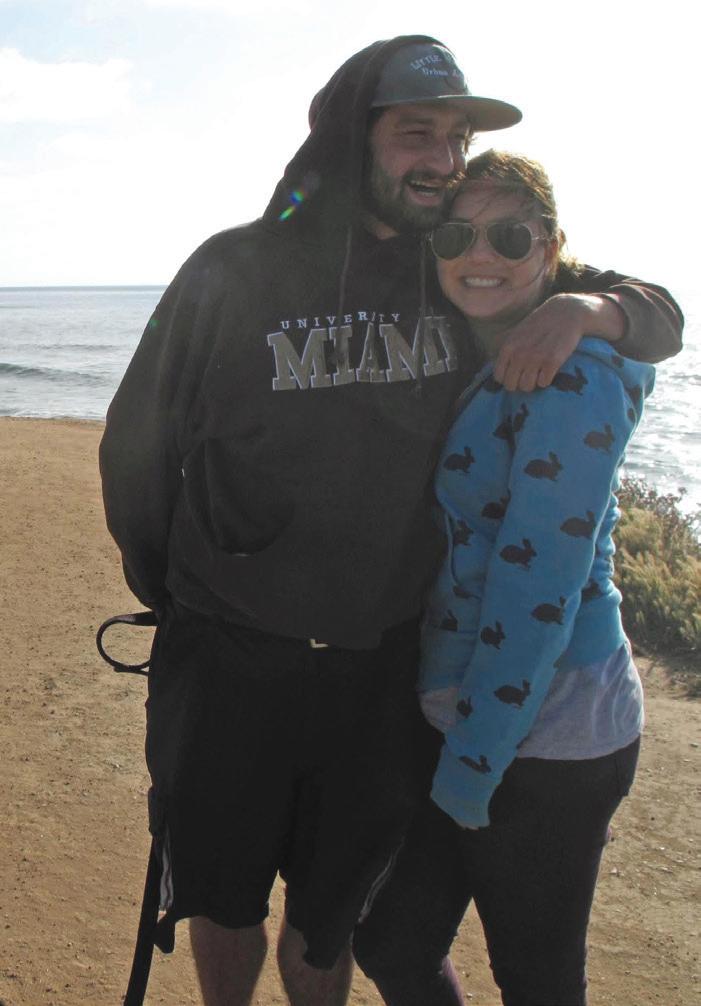









We’re now nearly mid-way through Foodie February – a time for comfort foods to get us through those cold and darker days and nights, as well as romantic meals to share with loved ones – whether new dates or forever partners.
Most first and early dates center on, or at least somehow involve, a meal. If not a formal dinner, a movie date might include popcorn, a ball game a hot dog, and a hike a picnic. That’s why for our lead article for this Food and Romance section, Stephanie Peck checked in with eight area couples to learn what they ate on their first dates. The range is vast – from a mom’s sandwiches to fancy-shmancy-upscale restaurants and nearly everything in between. Their stories are fun to read and begin on the next page.
When David Leon shared with me over this past Thanksgiving weekend that he bakes, we knew Jewish News had a story about to rise. Along with David, Joel Nied and Scott Rosenblum tell readers what enticed them to learn and perfect the art of baking. Page 24.
Long-time Norfolk residents all surely know Charlie’s Diner on Granby Street in Ghent. The restaurant’s new owner, Yogev Kremisi, is serving up kosher food at Charlie’s Middle Eastern Cuisine and getting rave reviews. Page 30.
A well-known name in the culinary world, Michael Solomonov has a new cookbook, Zahav Home, and a couple more restaurants, too. The article about him and his longtime collaborator, Steven Cook, can be found on page 28
Mid-February also brings the practically national holiday of romance, Valentine’s Day. Trying to think of a gift or a place to dine? Our advertisers offer some terrific options.
Wishing you a B’tayavon! – or Bon Appetit! – and a month filled with all kinds of love,


Terri Denison Editor

Stephanie Peck
A shared meal can lead to a good laugh, a lifelong romance, or a future business venture – and sometimes, all those things and more. ❦ For these eight couples, first dates that included peanut butter and jelly sandwiches, COVID dating, and dancing at the top of Chicago’s John Hancock Building resulted in ceremonies under the chuppah. Even if what was on the menu didn’t matter, the memories clearly do.
Sharon and Mark Goldner
(as told by Sharon)
Mark and I met during the summer of 1991.
Before sharing a meal, we had a few drinks at Worrell Brothers at the Oceanfront. A few days later, Mark made me a peanut butter and jelly sandwich. Later, his mother said, “If I had known she was Jewish, I would have made her something better than a peanut butter and jelly sandwich.”


Our first real dinner date was at Rockafeller’s, where we enjoyed the conversation and the views. I wasn’t sure it was going to work out because he wanted three children and I said two, but we figured it out…
Stephanie and Sam Steerman (as told by Stephanie)
We met at a big New Year’s Eve party at the National Constitution Center in Philadelphia in 2005. This photo is from that night. Sam was in medical school at Jefferson, and I was an admissions director at Drexel.

Our first meal together wasn’t until Valentine’s Day, and, because of Sam’s ‘busy schedule’ (insert my eye roll), it was only dessert. That said, it was a delicious chocolate dessert at the popular Alma de Cuba restaurant. Since that time, Sam has taken me out for a full dinner many times. Cheers!
Callah and Brandon Terkeltaub (as told by Callah)
Brandon’s first jobs were at Steinhilber’s and Ruth’s Chris, so we had no shortage of delicious date nights early on in our relationship.
One of the first memories I have is of Brandon saving up for a very nice white tablecloth dinner for one of our first dates. He borrowed his dad’s car and was so nervous that he accidentally left the headlights on when we went into dinner.

When we came out, the battery was dead, and he had to call for a jump. He was so embarrassed, but I thought it was really cute how flustered he got. Plus, we got to hang out longer while we waited for a jump.

Joslyn and Ari Stein (as told by Ari)
Joslyn and I met in 2008 at a Halloween party in Portland, Oregon. The next day we went to a diner for coffee and donuts. Neither of us can remember the name of the diner, or the kind of donuts we ate, but they must have been delicious, because I called my mother immediately after we left and told her that I had just met my future wife.
Jody and Alan Wagner (as told by Jody)
On our second date, Alan and I went to Benihana on Michigan Ave. in Chicago. Back in 1976, a Japanese chef cooking food in front of us was very special!

We shared a fancy drink from a porcelain buddha, which memento we still have today. After dinner, we walked to the John Hancock Building to go dancing on the top floor. On our path, Alan found a $10 bill on the ground—I think he took it as a sign, and three years later we were married!
Also, our dates in downtown Chicago almost always included caramel corn, and especially Garrett’s popcorn.

Patti and Jules Wainger
(as told by Patti)
Iam originally from Birmingham, Alabama and met Joan London when we went to Goucher College in Baltimore together. During our first week, as freshmen, Joan had two guys coming up from the Medical College of Virginia (Fred Rosenblum and Jules). She told me not to mention my age (I was 17 at the time), because they wanted seniors. Fred and Jules flipped a coin to see who would go out with whom. That was our first date.
Our second date was at the Chesapeake Room in downtown Baltimore, an upscale seafood restaurant. I was impressed, because we had no income as students! Jules ate hamburgers and tuna fish all week so he could afford to take me to dinner on Saturday nights!
Jules was a perfect gentleman, and I just looked forward to seeing him. The Chesapeake Room became our favorite restaurant.
Betsy and Erik Cooper (as told by Erik)
Betsy and I have always enjoyed nice meals over our 34 years of marriage. On one of our first dates, we went to dinner at La Galleria, which was then a new restaurant in downtown Norfolk. The waiter immediately recognized Betsy from her shop at the Waterside Festival Marketplace. He took her order for dinner, but I had to remind him to take mine. We proceeded to have a nice conversation, and we were both enjoying our dinner experience, but as the various courses started being served, I noticed some issues. He took Betsy’s drink order, but not mine. He would offer Betsy pepper for her salad, but not me. When the main courses came, he offered Betsy parmesan cheese, but again, not me. This continued throughout the meal. And when he came to check on our table, he would only talk to Betsy.

When we had finished our dinner and the check was delivered to the table, the waiter handed the bill to Betsy. As I was paying the tab, I mentioned to her that I didn’t think the service was great. Betsy asked why because she thought the service was stellar. I then mentioned all of the issues I saw that evening. We both had a good laugh, and didn’t hold it against the restaurant as it became one of our go-to restaurants in town. The waiter must have been nervous as the restaurant was new and it was his first job. We still get a good laugh from this memory.
Emily and Ben Leon
(as told by Emily)

Our first official date was on March 13, 2020, at Esoteric in Virginia Beach. This was the same day I drove back to Virginia Beach from my then home in NYC due to the scare of COVID. We shared a couple of plates including duck tacos and a hummus platter. We have enjoyed going back routinely ever since. They also have a great happy hour!






SHARE YOUR MILESTONE WITH US

















Whether you’re walking down the aisle or gathering with family and friends to celebrate a mitzvah, our downtown Norfolk waterfront venue is the perfect place for your celebration. Our event specialists will work with you closely to transform your vision into an unforgettable celebration, incorporating stunning decor and exquisite cuisine.
Stephanie Peck
Baking is a science that requires the precise chemistry of all ingredients. One misstep and a decadent dessert devolves into a tragic mess, a puffy souffle deflates into a cavernous hollow, or a delicate confection becomes a misshapen blob. ❦ David Leon, Joel Nied, and Scott Rosenblum have each perfected their art of baking through trial and error. For Jewish News, they share when they became bakers and how the hobby brings them joy.
David Leon
President of United Federation of Tidewater and a past president of Strelitz International Academy, David Leon is a Portsmouth native who once owned a trash hauling business.
Jewish News: How long have you been a baker?
David Leon: Five years.
JN: What prompted you to start baking?
DL: I've always cooked a lot and wanted to learn how to bake but was afraid to try. When the pandemic started, I asked Tami Arnowitz for her challah recipe and any pointers. She invited me to a zoom challah class at her new synagogue in Westchester, N.Y. I enjoyed it and realized it wasn’t as scary or difficult as I had imagined.
From there, I tweaked and modified her recipe as I learned new things and taught myself other recipes I found online.
JN: You work in the baking industry. How is it different from baking at home for yourself?
DL: As friends and family ate my creations, many suggested that I sell my challahs or start a bakery. Having had my own business before, I knew this was something I didn’t want to do.
Alvin Wall suggested I work at a bakery/restaurant next door to where he and his wife, Nancy, do pottery. About two and a half years ago, I started working at Prosperity Kitchen & Pantry a few hours a week for fun. I don't really bake much there – mostly I do prep work and make various prepared foods. But I’ve learned new recipes and skills. The serving sizes are much larger, and I use large commercial equipment which
I enjoy.
They have an open kitchen so it’s funny to see the reaction of people I know when they see me working there most Thursday afternoons. I’ve had to use much self-control not to eat the extra food which is always available and hidden from view from the customers.
JN: How often do you bake? Do you share your baked goods?
DL: I mostly bake challah, which I do for Shabbats when my girls are with me. I like that I’m creating Jewish food memories for my girls.
I also like the reaction from sharing with friends and family. I’ve made challahs for my niece and nephew’s weddings and for our family Rosh Hashanah luncheons and other gatherings.
If I’m invited to a Shabbos dinner, I will usually bring one of my challahs. I
sometimes think this is the only reason I’m invited! For family Hanukkah gifts, I frequently bake cinnamon babka or Mandel bread. And for Pesach, I like to make my own matzah. Now I understand why many people give away baked goods.
JN: What is your favorite thing to bake?
DL: Challah is my favorite and most frequent thing to bake. But I also enjoy making cinnamon babka, Mandel bread and soft pretzels. I’ve made bagels a few times but they’re a lot of work.
JN: Do you have a favorite recipe you’d like to share with Jewish News?
DL: It’s funny how some people are so secretive with their recipes. I’ve found that most recipes are very similar, and I don’t mind sharing mine. (page 26)

Originally from Jacksonville, Florida, Joel Nied is a partner at the law firm Price Benowitz LLP. He serves as president of the Virginia chapter of Friends of the Israel Defense Forces (FIDF) and as a board member of Beth Sholom Home and Tidewater Jewish Foundation, among others.
Jewish News: When did you start baking?
Joel Nied: I’ve cooked since college, but the baking began in earnest probably around 2016.
Jewish News: Did someone or something inspire you to bake?
JN: I read somewhere that one of the best ways to instill a sense of the importance of Judaism in your kids is to light candles every Friday night. And what better way to get them to look forward to it than offering some freshly made challah?
I sought out a recipe that was low effort, as opposed to one that looked or tasted perfect, with the idea that if it was easy to make, I would do it more often. As it turned out, I managed to come up with a recipe that is easy to make and tastes and looks fantastic. As a result, I’ve made it pretty much every Friday for the past seven to eight years. Family and other people who have had it, love it. I bring it to neighborhood happy hours and the neighbors love it (even though they don’t know what it is) and I send them to my son in college. It’s a big hit and easy to make. Everyone should do it. Don’t strive for perfection. Just do it.
Jewish News: How often do you bake? JN: Pretty much every Friday for challah.
But I realized quickly that baking (and food in general) was a great way to introduce my kids to the broad spectrum of Jewish traditions and our collective heritage. As a result, I look out for food from everywhere. We regularly make fazuelos for Purim (OK, technically not baking, but it involves dough), strawberry jelly and chocolate sufganiyot for Hanukkah and, whenever we’re in the mood, khachapuri and, of course, babka.
Jewish News: What is your favorite thing to bake?
JN: Khachapuri is something the family goes crazy over whenever we make it. But the crowning achievement is babka. I am not exaggerating when I say our babka is possibly the best on the East Coast. Maybe the country. That’s not just me. It’s so good that someone consumed one so quickly, it almost killed him; he sucked it into his lungs and had to go to the hospital.
I’ve taught Simone, my daughter, the recipe and technique and she can replicate my results. Please don’t ask whether it’s chocolate babka. That’s like asking whether a martini is a gin martini. Of course it’s chocolate. Simone, however, did come up with a babka where one helix is cream cheese frosting and the other is a pecan/cinnamon filling. It’s awesome. We bake other things (like a confection we call “Cakepocalypse”), but there’s no connection to Judaism, other than the fact that we make it.
Rosenblum
Jewish News: How long have you been a baker?
Scott Rosenblum: I took my first Baking & Pastry class in 2022 as part of the curriculum in culinary school.
JN: You have worked in prestigious restaurants. How is baking in a professional environment different from baking at home?

SR: Baking in a professional kitchen is very similar to baking at home. Both are very exacting and require meticulous attention to detail. The main difference is that at work I must follow the executive chef’s recipe, while at home, I can be more creative and adventurous with ingredients and flavors.
JN: How often do you bake?
Baking is not just a hobby for Scott Rosenblum, who is retired from pediatric dentistry. A recent graduate of Culinary Institute of Virginia, this Tidewater native now works as a fulltime chef. He’s worked at Inn by the Sea in Portland, Maine, Primo in Rockland, Maine, The Surf Club in Miami, and Chef and the Farmer in Kinston, N.C. In Virginia Beach, Rosenblum’s kitchens include TuLu, Eurasia, and Yorkie’s.
SR: I enjoy baking, so I do it as often as I can. I get a special sense of accomplishment when I make something delicious from scratch that my guests really enjoy.
JN: What is your favorite thing to bake?
SR: Some of my favorite things to bake include focaccia bread, profiteroles, and biscuits.
JN: Anything you’d like to add?
SR: As Julia Child famously said, “A party without cake is just a meeting.”


“Mandel bread reminds me of my grandmother who made it frequently,” says David Leon. “She never wrote down her recipe, but with help of various recipes that friends shared and the internet, I've created one that combines them all to a certain extent.”
Ingredients:
2 sticks of softened butter (16 tablespoons) or 1 cup vegetable oil or olive oil for Parve
1 cup sugar
3 large eggs
1 tsp pure vanilla extract
3 cups all-purpose flour
1 tsp baking powder
1/2 to 1 tsp salt
1 cup of lightly toasted chopped almonds
1/2 cup mini-size semi-sweet chocolate chips (optional)
Ground cinnamon and granulated sugar for dusting
Directions:
• Mix butter/oil and sugar until combined, then add eggs one at a time. After the eggs are combined, add vanilla.
• Lightly toast the chopped almonds for 6 to 7 minutes. Let cool and set aside. If they’re added while still hot, it will melt the chocolate chips which you don’t want to do.

• Sift together all the dry ingredients and add them slowly to the sugar/ egg mixture.
• Once the dough is smooth and sticky, pour the almonds and optional chocolate chips in and mix.
• Place dough on wax or parchment paper, cover with plastic wrap and place it in the refrigerator for a few hours (at least 2) or overnight.
• Lightly oil your hands and form 3 long rows with the dough onto an ungreased cookie sheet (I line the cookie sheet with parchment paper for easy cleanup). Each strip of dough should be 3-4 inches wide. They will spread out a lot during cooking, so make sure you leave enough space between the rows. A trick used by my Grandma Frieda is to shape the logs of dough using an oldfashioned metal ice tray (the ones with the handle and curved edges) as a mold.
• Bake at 350 for 25 minutes. While Mandel bread is baking, in a flat shallow dish, combine 3⁄4 cup of sugar with enough cinnamon to turn the mixture light brown. It’s best to eyeball this – it shouldn’t be too brown or too white.
from everyone in the house, which makes it rise. When everyone eats it, the love is redistributed in the household. If it doesn’t rise, there are bigger problems than a flat challah. Just make it.”

• Take the Mandel bread out and turn the oven down to 300 degrees. Slice the Mandel bread into biscotti sized pieces (~1").
• Roll each cookie into the cinnamon sugar mixture. Put the pieces back upright on the cookie sheet. Sprinkle excess cinnamon sugar on top of the pieces.
• Bake for another 20 minutes until they’ve achieved the texture you desire. The longer they stay in the oven, the crisper they will be. If the slices are big or wide, you might need longer than 25 minutes. Keep an eye on it and don’t over-bake, as this cookie tends to dry out quickly. Store in an airtight container.
“Make it. It’s easy,” says Joel Nied about his challah recipe. “I’ve done all the hard work already by identifying the right ingredients and the process. At this point, I’ll be insulted if I don’t hear from someone that he/she read this article but didn’t try the recipe. There’s a legend that what makes challah dough rise isn’t the yeast, but rather the love in the house. The dough sucks up the love
3 1/2 cups (or better yet, one pound two ounces) bread flour (Bob’s Red Mill Artisanal bread flour is what you should use.)
1/2 tablespoon salt
1/2 tablespoon
Fleischmann’s active dry yeast
2 eggs
1/4 cup honey
1/4 cup grapeseed oil (do not use vegetable oil - use grapeseed oil!)
2 eggs
.9167 cup warm water (it’s a 2/3 cup + 1/4 cup)
• Add honey, warm water, and yeast (in that order) into bowl. Wait until yeast starts foaming.
• Add oil and eggs. Mix.
• Add flour and salt. Knead by hand or use mixer with dough hook for 5 minutes.
• Cover and put in warm place (like an oven with the light on/set at 100 degrees) for 1.5 hours (or in refrigerator overnight). If the air is dry, put a mug of steaming water next to the dough (except in refrigerator!).
• Put dough on floured surface and separate into 4 or 6 pieces, depending on the braiding style (look online for instructions). Roll into long pieces (around 15 inches each) and braid.
• Let rise for 40 minutes in a warm place.
• Brush with a scrambled egg.
• Put in an oven at 350 degrees on the lower third rack for 24 minutes. Or, if you make 2 challahs with the dough, 21 minutes.
• Let cool for at least an hour.
• Light candles. Drink wine. Eat. If you eat it while the challah is still warm, it is like an unglazed doughnut. If you eat at room temperature, it is like great challah.
Lior Zaltzman
Kveller – In the spring of 2023, Jewish Matchmaking showed the world the complexity and the beauty of finding your Jewish bashert — your soul mate. While none of the couples featured on the Netflix dating show wound up finding their happy ever after, they gained valuable insight into how to go about looking for love, and some of them even wound up getting engaged and married not long after the show to people they met on their own.
That was all thanks to the matchmaker at the helm of the show, Aleeza Ben Shalom, an Orthodox Philadelphia transplant who lives with her family in Israel. And while season two of Jewish Matchmaking is on hold, Ben Shalom and her desire to help others find romance isn’t. Earlier this month, she released Matchmaker, Matchmaker, a tome full of the delightful dating anecdotes that viewers learned to love in Jewish Matchmaking, flanked with her pearls of wisdom and advice. Some will be familiar, like her “date ’em till you hate ’em” principal, while others are new exciting tricks to add to the toolbox of anyone who is dating or has a loved one who is.
“high quality human,” the kind of person one should be on the lookout for when searching for a potential spouse.
Ben Shalom’s advice feels solid for how to be human in the world. The concept of a “high quality human” can also apply to platonic relationships. Anyone can be a highquality human, she says, “you just have to work really hard at it.”

Ben Shalom brings her vibrant, positive spirit to the book. It’s the love and the dating stories that take center stage here. Instead of the prescriptive “do this, don’t do this” found in other dating manuals, she aimed to include content that is relatable to anyone who’s had a hand at modern dating. “You read it and you’re like, ‘Oh my, I’ve been there. That happened to my friend, that happened to my co-worker…” she says.
When it comes to the concept of “bashert,” Ben Shalom acknowledges that there’s “a lot of pressure on that word,” with people often believing that if something’s “meant to be” it means that “everything should just always work.”



“It’s not written for Jewish readers,” Ben Shalom says, or at least, not only Jewish readers, adding that the target audience for her book is “marriage-minded singles who want to find a loved one, or for anybody who wants to play matchmaker.” Jewish wisdom does weave itself into the book, and attuned readers will notice that some of the characters in the anecdotes she shares are Jewish or Israeli like the story of Ron, a veteran amputee and one of Ben Shalom’s clients who she describes as a
“Being your soulmate, being your bashert, being meant for each other, does not equal perfect relationship, no problems ever,” she says. “It’s like they’re perfectly imperfect for you. That’s what bashert is. They’re exactly what you need and what you don’t need. It doesn’t mean you’re going to have no issues in life.” Ben Shalom wants daters to ask themselves, “Who do you want to walk to the hospital with? Who do you want to go to a funeral with? Who do you want to deal with debt or challenges or losses? That’s the person that you want to pick.”
About the second season of Jewish
Matchmaking, Ben Shalom says, “The world and the Jewish world is so complicated. There’s war.” You can’t film.
Ben Shalom has seen her work vastly shift since October 7. “So many more people are very intentional about wanting to date Jewish,” she says. “People who said, ‘I date anybody, it doesn’t matter’ are [now] like, ‘No, I need to marry somebody Jewish. There’s a lot more going on in the Jewish world, and I don’t feel like somebody will understand me if they’re not Jewish.’ And they’re right, they won’t fully understand them. So there’s been a lot more of a buzz for Jewish singles to
Feeling ever so beautiful in jewelry from G Marie
date only Jewish matches. I would say that people are also feeling like, ‘Oh my gosh, the whole world is in crisis, the world is falling down and everything’s unstable. I need a partner now!”
Ben Shalom hopes that people pick up matchmaking in the same way they pick up her book. “I want to make sure that people know this is not just for singles. This is for anybody who wants to be matched, or anybody who wants to help match. I think that’s what I would want somebody to know: Here are incredible tools and stories that you can learn to set yourself up, set up a friend, help this one and help that one.”



















Don’t forget to wear your costume!









CELEBRATE PURIM WITH PJ LIBRARY IN TIDEWATER! MARCH 9 • 1-4PM • SIMON FAMILY JCC


Get ready for a fun-filled afternoon of making hamantaschen with friends and family! While your treats bake, you can arrange Mishlochei Manot (gift baskets) for local organizations and agencies that support the Jewish community.







of Jewish communal venues across the United States — marking a slight departure from their last launch, when in addition to a range of Jewish and non-Jewish venues, the pair also had a series of appearances at Williams Sonoma stores.












































SEATS LIMITED. REGISTER TODAY! Gather your courage, don your costume, and prepare




Rachel Ringler (JTA) — A lot has changed since the last time Michael Solomonov released a cookbook, back in 2018. The celebrity chef has opened several new restaurants. He has expanded his empire beyond Philadelphia to New York City. And of course he has watched his native Israel, the flavors of which have defined his career, come under attack.













At a time when some Jewish creatives and personalities have openly questioned whether they are welcome in non-Jewish spaces, Cook says he and Solomonov have a different reason for sticking to a Jewish circuit.


































After Solomonov raised money for emergency services in Israel following Hamas’ Oct. 7 invasion, proPalestinian protesters in Philadelphia took aim at him. They staged a protest outside Goldie, his kosher falafel joint, accusing it of “genocide,” and called for a boycott of his restaurants, some of which have Hebrew names.




“It is a built-in audience for what we do,” Cook says. “Jewish communities have been incredibly supportive of all of our books, and we got enthusiastic responses when we started making inquiries.”

Neither Cook nor Solomonov had planned to write a third cookbook after releasing Zahav in 2015 and Israeli Soul in 2018. But then came the pandemic.











What the protesters haven’t done, Solomonov and his longtime collaborator Steven Cook said, is dampen appetites for their food.
“Since Oct. 7, we are busier than ever,” Cook said during a launch event in New York City last fall for the duo’s third book, Zahav Home, named for their first, and highly acclaimed, restaurant.
“We all know how challenging it is out there right now,” Cook said. “Fortunately, for us it is a lot of noise. Our customers have doubled down in their support for us.”
Cook’s comments came during an appearance with Solomonov at the Streicker Center at Temple Emanu-El on Manhattan’s Upper East Side, the day that Zahav Home hit shelves. Their tour took them on a circuit
“On March 16, 2020, everything stopped,” the partners write in the introduction to their book. “In a matter of a few hours, we went from more than four hundred employees to zero employees.”
The two men, who had then been business partners for 16 years, lived a block apart at the time.
“At the time that lockdown happened, we had been going to Zahav every single day for 13 years,” Cook says. “All of a sudden, we couldn’t go there anymore. Our days were spent doing laps around this park. We thought our businesses would wither away, so in an effort not to be so depressed, the
conversation turned to, ‘What did you cook for dinner last night?’ or the lunch I made for my family every day.”
Solomonov says, “Being able to cook for our families and then to have things to discuss and a creative outlet was cathartic.”
The partners realized they had a theme for a book, which they started in 2021 and completed the following year.
“We decided that since we were going to focus on home cooking, we would shoot in an actual home kitchen,” Cook says. “Mike lost the coin toss, and everything was shot in his house. Everything in the book was cooked start to finish from scratch. Nobody was handing us preprepped ingredients. The recipes were improvised along the way.”
The book is made up of 125 recipes, all of which have Israeli and/or Jewish roots. So, there is Eastern European matzo ball soup and Moroccan harira; Shira’s potato kugel flavored with parsley and dill; and phyllo bourekas stuffed with Swiss chard and feta.
Many of the recipes in Z ahav Home appeared in their other books but have been streamlined for the home cook. Their chraime, for example, a North African fish stew typically eaten on Shabbat, was prepared with a whole fish in Zahav. In Zahav Home, the recipe calls for boneless fish filets.
“We grew up a little,” says Solomonov. “The Zahav recipe is more fussy. I like to think that over the years we have changed, and this is more realistic for the home cook. We are cooking for our families, on weeknights, with a time crunch which forces you to take different directions for the same recipe.”
The book starts with photos and descriptions of some of the condiments and spices that you would need to have on hand to cook some of the food in the book, such as baharat, a sweet and savory spice blend; pomegranate molasses; the fermented mango condiment amba; and smoked cinnamon, which they use in their lentil soup and kebabs.
Solomonov and Cook have been using these ingredients for years. But another thing that’s changed since they opened Zahav 16 years ago — and maybe in part because of their influence — is that those ingredients have become relatively easy to obtain.
“People are more familiar with the pantry ingredients that are fundamental to the food that we cook,” says Cook. “Certainly, you can find a jar of harissa in any supermarket in America. And the quality and availability of tahini and everything else have improved.”
Although Cook says you don’t have to be Jewish to use the book — and their restaurants have a following that goes beyond Jewish diners — the authors do assume some familiarity with Jewish culture. They describe, for example, their Spatchcock Chicken recipe with Hungarian Seasoning as being perfect for Shabbat.
“I feel like ‘Shabbat’ is in the New York Times crossword puzzle so it’s fair game,” says Cook.
Harder to detect might be the fact that almost all the recipes in the book would be accessible for cooks who keep kosher. The book does not advertise itself as comporting with traditional Jewish dietary laws, but none of the recipes call for non-kosher ingredients, including shellfish or non-kosher meats, and only one mixes meat with milk, a forbidden combination under the laws of kosher eating.
“That is our guiding idea at Zahav,” says Cook. “It is not a kosher restaurant, but we never serve traif, and we never mix meat and milk. But we couldn’t resist [including a recipe for] those meatballs mixed with parmesan cheese. We left that in there as a little Easter egg for people to find.”
The philosophy has extended far beyond Zahav. The pair’s other restaurants — Laser Wolf, Dizengoff, and K’far — do not serve pork or shellfish. (They do serve non-kosher meat and, unlike Goldie, do not carry kosher certification.) Last year, they opened Aviv, a cross between Zahav and Laser Wolf in Miami, complete with a charcoal grill and fresh Yemeni flatbread.
Also last year, they opened a new restaurant called Jaffa Bar in Philadelphia.
“It breaks our kosher streak,” says Cook. “It is a seafood bar.”
But while the food is the main point of their joint business, CookNSolo, in the post-Oct. 7 world they see their latest book as being about more.
“We are seeking ways to either connect to the community or find joy in challenging times,” Solomonov says, “and we are hoping that this book will provide a little bit of that.”




Getting engaged or married soon? Jewelry from a chain store just won’t cut it. You want something unique. We can design that special mounting for your family diamond or supply you with the perfect diamond.
Your diamond is loose, or it fell out and you’re in a panic. Nunez can repair it for you right on the premises in our fully equipped shop. Where the owner/jeweler has 40-plus years of experience. Most repairs are done in 48 hours.



The ring on your finger is generations old, and you want to keep it in the best shape possible. You’d like to restore it. Nunez can restore your antique piece to the look of its original era so you can wear it with confidence.

Nuñez Fine Jewelers




Stephanie Peck
Charlie’s Middle Eastern Cuisine opened in Norfolk’s Ghent neighborhood in November. The intimate and friendly kosher restaurant is supervised under the Vaad HaKasharus of Tidewater.
Yogev Kremisi, the restaurant’s owner, also owns Dream the La Cream, an ice cream parlor in Virginia Beach. He says he searched for seven months to find a restaurant location – landing at the site of longtime diner, Charlie’s Café on Granby Street.
A native Israeli who is now a U.S. citizen, Kremisi met his American wife in Israel, where he worked in mediterranean cuisine.
Kremisi says he is pleased with the early response to this new venture and is working on the restaurant’s website and establishing accounts with delivery services Uber Eats and Door Dash. A Shishi menu, carry-out for Shabbat, is also available. Kremisi says his favorite dish on the Charlie’s menu is the Chef Kabob plate, since “it’s completely made from zero.”
What’s next for Kremisi? “Kosher dairy, maybe,” he says.





















